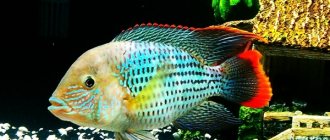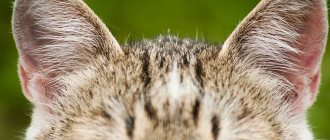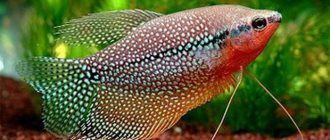Fish, which inhabit almost all types of water bodies, are characterized by the greatest variety of reproduction methods among animals. Over a huge period - more than 400 million years, fish have mastered reservoirs with fresh and salt water; they live at various depths, in high-mountain and underground reservoirs, in rivers and streams with fast currents and in stagnant silted floodplains and swamps. The environment and living conditions require adaptation for the survival of not only adult individuals, but also for maximum preservation of offspring. From this point of view, it is very interesting to get acquainted with the facts of how fish reproduce and what this gave to each species.
Classification of fish according to breeding conditions
Most fish species release reproductive cells into the external environment, and fertilization, as well as their further development, occurs outside the female’s body. The majority of species do not take care of their offspring, and some even eat larvae and fry. But they choose places for spawning, which are often vast distances from their usual habitat.
There are species of fish in which the parental instinct is highly developed. They build special nests for fertilized eggs, take care of and protect the territory. Some fish bear their offspring inside the body or on its surface, in the mouth. Moreover, both females and males take care of the offspring.
According to Kryzhanovsky S.G.
According to the classification of Professor S.G. Kryzhanovsky, adaptive features in fish are noted in the early period of development. The habitat differs not only for different species of fish, but also at different stages of life. Fish breed in certain seasons and choose the most suitable areas of water bodies for spawning. Changes in the environment cause:
- fish fertility,
- type of fertilization and type of development of offspring,
- peculiarity of sexual cycles,
- distribution and migration,
- the possibility of relocating to reservoirs with a different hydrological regime during spawning.
According to the localization of the masonry, S.G. Kryzhanovsky divided all types of spawning fish into:
- pelagophilic - spawning in water,
- lithophilous - laying eggs on stones,
- phytophilous - on plants,
- psammophilous - on sand,
- ostracophilous - into the gills of bivalve mollusks,
- protecting their eggs.
This classification has been used in ichthyology for more than 170 years. 50 years after Kryzhanovsky’s classification, the famous ichthyologist Balon compiled his own classification, more detailed, which indicates not only the location of the laying, but also the types of nests being built, the type of laying eggs on a substrate and without a substrate, and a detailed analysis of viviparous fish species.
According to Balon
The eggs of some fish are able to swim both in the thickness and on the surface of the water, being in a state of lack of oxygen, and in some fish the eggs are able to be in diapause and remain viable without water. The laid eggs can be located above the surface of the water - on coastal stones or plants, and the male periodically pours water over them so that the shell does not dry out.
The types of nests that fish build are also very interesting:
- from foam,
- from a mixed substrate and material,
- glued sockets,
- from plants and their remains,
- from sand,
- on the surface of soil and stones, as well as in crevices and cracks,
- under the protection of sea anemones.
The adaptive features of fish that externally bear their offspring are striking. Depending on the location, the following types of fish are distinguished:
- moving their brood. They carry eggs in body cavities or on any part of it,
- bearing on accessory organs. They glue sticky eggs between the fins, on the skin. The female curls herself into a ring around her eggs,
- bearing eggs in the oral cavity. Growing larvae can feed from the yolk sacs or immediately after hatching they can come out and feed outside,
- gestating in the brood chamber or in the gill slits.
Viviparous fish also carry fertilized eggs. Internal gestation can be with complete or incomplete transformation. When incomplete, the fish lay zygotes - eggs, at a certain stage of development. When fully metamorphosed, the female gives birth to fully formed fry.
How do fish reproduce?
There are monogamous and polygamous, responsible parents and caviar-eating pets.
Sexual method
Sexual reproduction predominates in aquarium fish. Methods for fertilizing eggs:
- Interior. Insemination occurs in the body. Characteristic for viviparous women.
- Outer. The eggs are fertilized in the pond. Refers to spawn-laying.
Depending on the development of eggs, there are three types:
- Viviparous. Development and gestation occurs inside the mother. The embryos feed directly from the mother's body. Breeding is easy due to the high survival rate of the offspring.
- Ovoviviparous. The fertilized eggs are attached to the posterior part of the oviduct. Difference from viviparity - the offspring are separated from the mother's metabolism, nutrition occurs from the contents of the yolk. The mother's body serves only to protect against external threats.
- Egg-laying (oviparous). Deposition of eggs in water.
Parthenogenesis
Parthenogenesis means the development of eggs without fertilization by a male. Rarely found in aquarium conditions. From the eggs, male and female individuals emerge, which over time regulates the numerical ratio of the sexes. This type of reproduction occurs in cyprinids, as well as commercial fish. Unfertilized eggs are adjacent to fertilized ones. Viable offspring rarely appear. Parthenogenesis is a sexual method of reproduction, since germ cells are involved, but gamete fusion does not occur.
Gynogenesis
Males and females of different species participate. As with parthenogenesis, the eggs are not fertilized. The male activates the spawning process. Offspring are born only female.
Hermaphroditism
The presence of male and female characteristics, manifested sequentially or simultaneously. Hermaphroditism includes changing sex during life or laying eggs and fertilization by one fish.
Reproduction
The predominant method of fish reproduction is sexual, in which different-sex individuals of the same species participate in fertilization. Along with sexual ones there are:
- Parthenogenesis – in which the development of the egg occurs without the fusion of male and female gametes. In some species, the development of germ cells goes through only the cleavage stage without the formation of a larva. Only in some cases do metamorphoses occur before the larval stage. In most cases, such offspring die. In salmon, fertilized and unfertilized eggs can coexist in one clutch.
- Gynogenesis is reproduction in which the germ cells of closely related fish species penetrate the eggs, but do not fertilize, but stimulate their development. As a result of gynogenesis, only female eggs emerge from the eggs. In Mexico, there are populations of mollies consisting only of females.
Most fish have male and female individuals (different sexes), but there are also hermaphrodites that combine the sexual characteristics of both sexes. In some species, sex changes occur with age. For example, in the red pagella, the ovaries begin to function as testes with age. In hermaphrodite guppies, ichthyologists have discovered the ability to self-fertilize, but the eggs are released unfertilized.
There are also differences in the method of fertilization. Highlight:
- external – in which fertilization of eggs by sperm occurs in the external environment,
- internal - when the male, using a pseudophallus, introduces the seed into the female’s reproductive system, where fertilization occurs.
In the latter case, the development of eggs occurs inside the female’s body, and fry are born, which immediately begin to feed on their own. Such fish are classified as ovoviviparous. In addition to ovoviviparous fish, there are also viviparous fish. In them, the lower parts of the oviduct form an analogue of the mammalian placenta. These include some species of sharks. In them, the nutrition of the larvae and fry is provided by the female’s body, and not by the yolk sac of the egg.
Depending on the nature of reproduction, all fish are classified into:
- monocyclic - representatives who spawn only once in their life, after which they die,
- polycyclic - spawning or giving birth to offspring throughout the entire period of life. These include most types of fish.
The rate of sexual maturation and productivity are of great importance in the life and reproduction of fish.
Peculiarities of offspring reproduction
The aquatic environment, which occupies 71% of the planet's surface, has provided organisms with large spaces for existence, from shallow waters to deep bottom waters. Evolution and environmental conditions have created many species of fish with different behaviors and ways of reproducing their young.
To understand the process of fish mating, you first need to understand the structure of the reproductive system. According to statistics, about 80% of all existing species are dioecious. The male reproductive system has the form of paired testes with excretory ducts that end in the genital opening. In the female, the efferent ducts connect to the paired ovaries.
In this video you will learn more about the mating of cockerels:
There are species of fish called hermaphrodites, in which the male is able to turn into a sexually mature female and vice versa. Gender change can happen once in a lifetime. For example, during the course of its life, a red pagellus can turn from a young female with ovaries into a mature male with testes.
Sexual reproduction
Sexual reproduction of offspring varies in different species. Briefly about the reproduction of fish, we can say that during fertilization, the sex gametes of the male and female merge, after which the formation of a zygote and the further development of the fish occur. Due to the fragmentation of the zygote, an embryo is formed. The fish leaves the egg as a larva. At first, the fish live off the yolk sac. The latter gradually resolves, providing nutrition and growth.
When the yolk disappears, the fish enters the fry stage and feeds on single-celled organisms and small crustaceans (daphnia, for example). The fry grows, switches to other food, and is only distinguished from adult fish by its size.
Fertilization can be external or internal. In most species it occurs in an aquatic environment. The female lays eggs, and the male inseminates her with sperm.
Internal fertilization also occurs, for example, in sea bass and guppies. It is carried out with the help of gonopodiums, which are also modified anal fins. Often such reproduction is accompanied by intrauterine development. Bearing offspring has its advantages: protecting the fry from predators and the formation in the womb of fry capable of active movement and independent absorption of food.
Parthenogenesis and histogenesis
This is one of the types of reproduction of offspring, while no sperm is involved in the fertilization of the eggs. This method of reproduction is considered sexual, since at least one sexual gamete is involved in reproduction. The egg is capable of developing independently until the crushing stage, and then, interacting with the fertilized eggs, it is activated. Thanks to this, unfertilized eggs do not rot, and the masonry does not deteriorate. Although the egg continues to develop and can reach the larval stage, after it, when the yolk is absorbed, many embryos die.
The exception is the Issyk-Kul chebak. When fish reproduce in this way, they produce numerous viable offspring.
Parthenogenesis occurs in the following families of fish:
- carp;
- sturgeon;
- salmonids;
- herring;
- and some other types of fish.
Histogenesis, as a type of reproduction of offspring, is a special case of parthenogenetic reproduction. Stimulation of egg activation occurs due to its interaction with the sperm of a male of another species close to the given species. Penetrating into the egg, the sperm stimulates it to further fragmentation, but nuclear fusion does not occur. The egg develops, and from it a full-fledged female organism is formed. Males do not appear during histogenesis.
Histogenesis occurs in silver carp and mollies, whose eggs can be stimulated to develop by the sperm of roach, carp and several other species.
Fish can be stimulated to mate
Timing of puberty
In fish, puberty occurs at different periods of life. The shorter a fish lives, the earlier it begins to reproduce. The variability of puberty ranges from 1-2 months to 15-30 years. Males mature earlier than females. The ability to procreate depends on the size of the individual. The better the fish eats, the faster it grows, the earlier it is able to spawn.
The metabolism of fish, and therefore life expectancy, is affected by water temperature. The higher it is, the faster the fish ages and the earlier it begins to spawn. Sexual dimorphism - visual differences between representatives of different sexes - plays a great role in creating a pair and successful fertilization. In some species it is difficult to distinguish females from males. In others, males have:
- larger size,
- more variegated, contrasting color,
- external genitalia - gonopodium or pterygopodia.
Sex differences may be present throughout life or appear only during the spawning period. This “nuptial outfit”, which occurs under the influence of activation of sex hormones, is typical for carp, whitefish, stickleback, salmon, and pink salmon.
Fish instincts
Fertilization is preceded by a series of events. They are a signal of readiness to reproduce.
Stimulation for mating
Many species approach reproduction very responsibly. Salmonids, for example, migrate from the salty ocean up to freshwater bodies to spawn. They can travel thousands of kilometers, making a dangerous journey up fast rivers, exhausting themselves to the end.
In many cases, males (such as guppies) are brightly colored to attract the female. In a mating dance, they circle around the gray females, trying to attract their attention. The lady will choose which male is the most colorful.
Males of other species can build “houses” from silt, mud and other bottom debris. If the female likes the house, the fish mate.
Certain conditions are required for mating
Changes to terms and conditions
Fish, like other living organisms, are subject to biological cycles. Mating occurs under certain conditions that occur with the change of season:
- change in daylight hours;
- change in water temperature (to be more precise, its increase);
- increasing the volume of food (fry need to eat a lot, for example, daphnia and single-celled organisms);
- increasing the concentration of oxygen dissolved in water.
The duration of gestation of eggs depends on the type of fish and can range from 12 hours to one and a half months. The age at which fish reach sexual maturity also varies greatly (from several months to 15-30 years). This depends on the species size and habitat conditions. The smaller the fish, the faster it reproduces and the faster it reaches maturity.
Fish, which inhabit almost all types of water bodies, are characterized by the greatest variety of reproduction methods among animals. Over a huge period - more than 400 million years, fish have mastered reservoirs with fresh and salt water; they live at various depths, in high-mountain and underground reservoirs, in rivers and streams with fast currents and in stagnant silted floodplains and swamps. The environment and living conditions require adaptation for the survival of not only adult individuals, but also for maximum preservation of offspring. From this point of view, it is very interesting to get acquainted with the facts of how fish reproduce and what this gave to each species.











